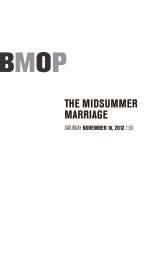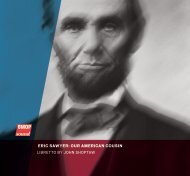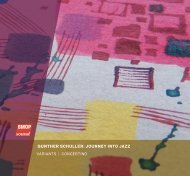Download the album booklet - Boston Modern Orchestra Project
Download the album booklet - Boston Modern Orchestra Project
Download the album booklet - Boston Modern Orchestra Project
Create successful ePaper yourself
Turn your PDF publications into a flip-book with our unique Google optimized e-Paper software.
I. “<strong>the</strong> Inventor.” musically, <strong>the</strong> work begins with a spareness of material unlike <strong>the</strong> o<strong>the</strong>r<br />
five concertos here. <strong>the</strong> solo violin begins with a very simple three-note idea, repeats it—<br />
each time adding a bit more material—playing with it, developing it. much like an inventor<br />
at work in his shop.<br />
II. “<strong>the</strong> Violin.” Jefferson was an accomplished violinist and highly knowledgeable about<br />
<strong>the</strong> music of his day in both europe and america. he lived from 1743 to 1826, dates which<br />
span <strong>the</strong> lives of bach, handel, haydn, mozart, and beethoven. this is <strong>the</strong> same span of<br />
time that saw <strong>the</strong> harpsichord gradually superseded by <strong>the</strong> forerunners of <strong>the</strong> modern<br />
piano. this section has extended passages using <strong>the</strong> harpsichord before <strong>the</strong> re-entry of<br />
<strong>the</strong> piano, taking us into…<br />
III. “<strong>the</strong> Garden.” among <strong>the</strong> many things in this garden (Jefferson was also a horticulturist),<br />
we find a reminder of <strong>the</strong> history of frame notation pointed out previously. but here,<br />
schwartz goes back to <strong>the</strong> classical-romantic preference for writing out arpeggios. <strong>the</strong>y<br />
first appear in <strong>the</strong> second violin and viola and are taken up later by <strong>the</strong> soloist.<br />
IV. “<strong>the</strong> letter” refers to correspondence with mariah Cosway, one of <strong>the</strong> great loves of<br />
Jefferson’s later life. here <strong>the</strong> harpsichord returns, this time as accompaniment to solo<br />
work by <strong>the</strong> flute.<br />
V. “<strong>the</strong> portrait” is, in a way, a summary of <strong>the</strong> previous four aspects. <strong>the</strong> portrait referred<br />
to is Gilbert stuart’s portrait of Jefferson, which hangs in <strong>the</strong> bowdoin College museum of<br />
art. this final section begins with <strong>the</strong> same tentative “invention” material as found in <strong>the</strong><br />
beginning, and reviews many o<strong>the</strong>r musical features including a return of <strong>the</strong> gently rocking<br />
arpeggio figures. <strong>the</strong> solo violin ends <strong>the</strong> work in a flourish in <strong>the</strong> style of a romantic<br />
concerto. but <strong>the</strong> harpsichord—throughout this finale—is nowhere to be found. <strong>the</strong>re is<br />
something bittersweet about this “loss” of <strong>the</strong> past, built into <strong>the</strong> overall form itself. as<br />
schwartz has noted:<br />
16 17<br />
<strong>the</strong> use of <strong>the</strong> harpsichord was important to me for two reasons. (1) It underlined<br />
<strong>the</strong> quoted references to 18th century music, which Jefferson knew very well. only<br />
mini-movements II and IV use those quoted references. and (2) my obsession with<br />
Jeffersonian “symmetry” led me to have movements II and IV act as mirrors of one<br />
ano<strong>the</strong>r. (I believe <strong>the</strong>y’re also <strong>the</strong> same duration!)<br />
stephen Guy soderberg is <strong>the</strong> senior specialist for Contemporary music in <strong>the</strong> library of Congress.<br />
© 2009 stephen Guy soderberg










